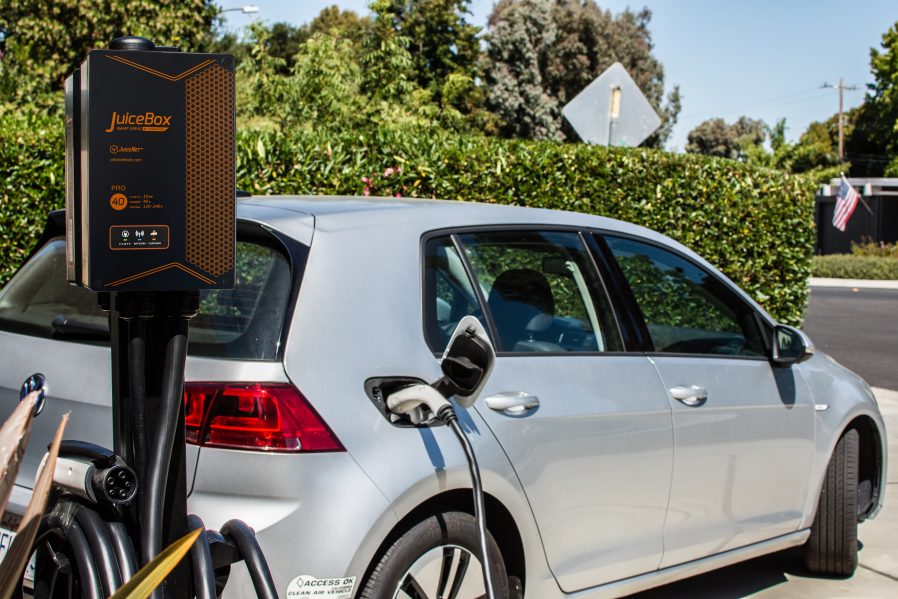What is EV smart charging? Why do we need it to move electric car adoption forward?
My wife and I bought our first electric vehicle six years ago this summer. It was a signature ‘Blue Ocean’ 2013 Nissan LEAF, which my sister-in-law affectionately named LEAF Erickson. We have enjoyed freedom from the pump, smooth and exciting driving, and the assurance of a simple drive train (as a mechanical engineer who inspects draw bridge machinery, I’ve grown a healthy distrust of moving parts).
Charging-Related Content:
We loved it so much we bought our second LEAF, LEAFam Neeson, in 2015, to go all electric. When I skid LEAFam Neeson into a tree after driving a refugee to work in a blizzard we replaced it with a 2017 Chevrolet Bolt, which we love just as much. Our joy of owning an electric vehicle has spread to my parents, who now own a 2019 Bolt. Electric vehicles continue to improve every year and I can confidently say I will never go back to gas.
Editor’s Note: Alex Waardenburg is very interested in electric vehicles and is currently working on a research paper about EV smart charging for his master’s degree program. He reached out to us with this article, as well as a survey that you can take to help him out with his research.
But, one aspect of driving an electric vehicle hasn’t improved and it really perturbs me. Electric vehicle charging is still so… dumb. EVs are sophisticated computers with massive amounts of energy storage and an internet connection, but their charger is no smarter than a coffee maker from the 1960’s!
Sure, every vehicle manufacturer has a pilot program, a partnership, or done a study of smart charging. Every time I see a new article about it I’m encouraged that it shows they recognize the potential, but they have not given consumers anything to show for it after almost a decade. All the while startups like eMotorWerks have successfully commercialized smart EV charging stations. It hurts me to say Tesla is no better and it has no excuse. It has the vehicles and the software, which it uses for charging its Powerwall. Why doesn’t Tesla give customers the option of charging their vehicle the same way a Powerwall charges?

A full implementation of smart charging would compensate the vehicle owner just by charging when electricity is the cheapest and reducing charge power when electricity is expensive. And, increasingly cheap electricity corresponds to times when renewable energy is abundant.
Accelerating the implementation of electric vehicle smart charging, complete with compensation, will accelerate the transition to electric vehicles by making them more economical and environmentally friendly. It will also accelerate the transition to renewable energy by giving utilities more control over demand to compensate for the lack of control over electricity supply inherent in renewable energy. That synergy will spiral as more renewable energy makes electric vehicles even more enticing and more electric vehicles make more renewable energy possible.
Of course, the true potential of smart charging can only be unlocked by utilities, and they are not going to play ball until EV smart charging reaches a critical mass to make it worth their effort. That will happen inevitably as electric vehicle adoption accelerates, but there are important steps vehicle manufacturers can take now to accelerate the point at which their fleet reaches critical mass. I believe the most important step is to work together.
If only Tesla and GM coordinated, they would double their fleet overnight and reach critical mass together because all of their vehicles are internet connected, and they could both utilize all of their current fleet. That would show manufacturers like Nissan the importance of including internet connectivity to all of their electric vehicles. Of course, they should coordinate with every manufacturer who is willing to reach critical mass even sooner in all markets. It would allow vehicles from small manufacturers (who may never reach critical mass on their own) to be utilized. Since it is all coordinated by software, each manufacturer can leave the conglomeration with their entire fleet overnight with a software update as soon as they reach critical mass on their own.

That is what vehicle manufacturers can do, but I am not a vehicle manufacturer. I also do not think venting on the internet is going to change anything or help anyone. No, my plan is to help manufacturers achieve critical mass another way; through increasing the utility of each electric vehicle.
I am writing a research paper for my master’s degree and I chose to write about a novel way to increase the utility of each electric vehicle for smart charging by allowing electric vehicle owners to select a target charge range instead of a single value. The target range gives algorithms additional flexibility to choose the absolute best times to charge, even from day to day, allowing electric vehicles to be used for medium term energy storage (some days are sunnier than others!). It also gives smart charging algorithms extra flexibility to deal with the unpredictability of energy markets.
In my research paper, I will attempt to quantify how much improvement it would provide. My analysis of using smart charging to increase self-consumption of solar power shows that using a target charge range improves self consumption by 15% over using a target charge value! However, modeling the benefits of other aspects heavily depends on how large users make their target charge range. That is what you can do to help.
I have made a survey to estimate how large EV owners will make their range to make my analysis more accurate. If you have driven an electric vehicle, would you please fill out my survey, so I can make my research even more useful to someone who does manufacture electric vehicles with, say, 310 miles of range and 220 miles of range?
